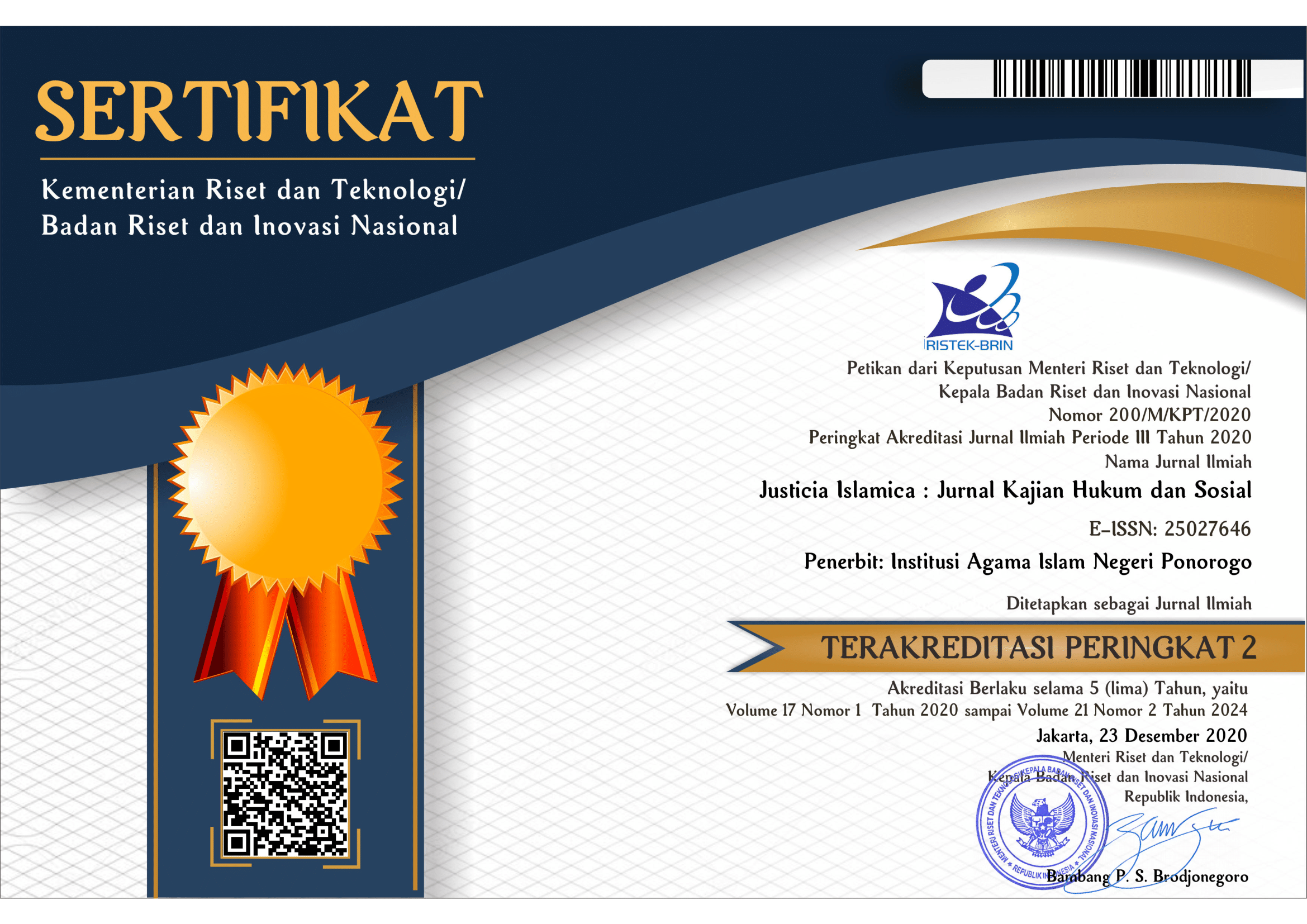Differences in Shalat Time Recording: Analytical Method of Kitab al-Khulashah al-Wafiyyah and Contemporary
DOI:
https://doi.org/10.21154/justicia.v19i2.3784Keywords:
al-Khulashah, salat, accuracyAbstract
The discussion on calculating Islamic prayer (salat) times contained in the Kitab Khulashah has its characteristics. The calculation process of salat beginning times has referred to the triangular ball algorithm system. Besides, there are also daqoiqut tamkin corrections presented through tables and calculator calculation methods. This interesting calculation can be studied; how the transformation system of salat time coordinates and the accuracy level of the salat beginning times calculation results. This study uses a library research paradigm with a qualitative theory verification approach using an arithmetic approach, and the results are presented descriptively and then compared with similar methods. The results show that the coordinate transformation refers to the modern astronomical system, and the calculation system has used spherical trigonometry (spherical triangle). The calculation results differ from 0 to 3 minutes with contemporary methods. Differences in data and methods cause it. Suppose the calculation is using the contemporary method. In that case, there is a difference of 0 seconds to 12 seconds. This indicates that modifications to the contemporary calculation system will produce a more accurate calculation when the calculation is made.
References
Al-Jailani, Zubair Umar. Al-Khulashah al-Wafiyah. Surakarta: Melati, n.d.
Amirudin, Abdul Majid, Ahmad Junaidi, Fakultas Syariah, and Iain Ponorogo. “Analisis Metode Hisab Kontemporer Terhadap Jam Istiwa’ (Studi Penentuan Awal Waktu Salat Di Fathul Ulum Kediri).” Antologi Hukum 1, no. 2 (2021): 97”“116.
Anugraha, Rinto. Mekanika Benda Langit. Yogyakarta: Universitas Gadjah Mada, 2012.
Azhari, Susiknan. “Tracing The Concept of Fajr In The Islam Mosaic And Modern Science.” Ahkam: Jurnal Ilmu Syariah 18, no. 1 (January 12, 2018). https://journal.uinjkt.ac.id/index.php/ahkam/article/view/9819.
Basthoni, M. “A Prototype of True Dawn Observation Automation System.” Jurnal Sains Dirgantara 18, no. 1 (2020): 33”“42. https://doi.org/10.30536/j.jsd.2020.v18.a3475.
Basthoni, M., and Hendro Setyanto. “Typology of Dawn Light Curves in High and Low Light Pollution Areas.” AIP Conference Proceedings 2391, no. January (2022). https://doi.org/10.1063/5.0073949.
Djamaluddin, Thomas. “Lokakarya Imsakiyah Ramadhan 1432 H,” 2. Semarang: PPM IAIN Walisongo Semarang, 2011.
Fadholi, Ahmad. “Analisis Komparasi Perhitungan Waktu Salat Dalam Teori Geosentrik Dan Geodetik.” Master Thesis, IAIN Walisongo, 2013. http://eprints.walisongo.ac.id/id/eprint/40/.
Fahrurrazi, Djawahir. Sistem Acuan Geodesi Dari Bigbang Sampai Kerangka Acuan Terestrial. Yogyakarta: Gadjah Mada Universitas Press., 2011.
Faiz, ABD Karim Faiz, and Wahidin Wahidin. “Prayer Time Variations: Case Study of Mosques in Parepare City in the Perspective of Contemporary Hisab and Islamic Law.” Elfalaky: Jurnal Ilmu Falak 6, no. 2 (December 7, 2022): 207”“29. https://doi.org/10.24252/ifk.v6i2.32727.
Hambali, Slamet. Ilmu Falak I Penentuan Awal Waktu Salat Dan Arah Kiblat Seluruh Dunia. Semarang: PPS. IAIN Walisongo, 2011.
””””””. Pengantar Ilmu Falak: Menyimak Proses Pembentukan Alam Semesta. Banyuwangi: Bismillah Publisher, 2012.
Hollander, H.G. Den. Ilmu Falak. Jakarta: J.B. Wolters., 1951.
Ismail. “Metode Penentuan Awal Waktu Salat Dalam Perspektif Ilmu Falak.” Islam Futura 14, no. 2 (2015): 218”“31.
Izzuddin, Ahmad. Zubaer Umar Al-Jaelany Dalam Sejarah Pemikiran Hisab Rukyat Di Indonesia. Semarang: DIPA IAIN Walisongo Semarang, 2002.
Kementerian Agama. Ephemeris Hisab Rukyat. Jakarta: Direktorat Jenderal Bimbingan Masyarakat Islam Kementerian Agama Republik Indonesia, 2013.
””””””. Ephemeris Hisab Rukyat 2021. Jakarta: Direktorat Urusan Agama Islam Dan Pembinaan Syariah Direktorat Jenderal Bimbingan Masyarakat Islam, 2021.
Khafid. “Modul Kuliah Astronomi Dan Hisab Kontemporer.” Semarang: Pascasarjana IAIN Walisongo, 2012.
Khazin, Muhyiddin. Kamus Ilmu Falak. Yogyakarta: Buana Pustaka, 2005.
Ma’u, Dahliah, Haliah. “Waktu Sholat Pemaknaan Syar ’ I Ke Dalam Kaidah Astronomi.” Jurnal Hukum Islam 14, no. 2 (2015): 269”“85.
Meeus, Jean. Astronomical Tables of the Sun, Moon and Planets. Virginia: Williamn-Bell Inc, 1983.
Mubit, Rizal. “Formulasi Waktu Salat Perspektif Fikih Dan Sains.” Al-Marshad: Jurnal Astronomi Islam Dan Ilmu-Ilmu Berkaitan 3, no. 2 (December 30, 2017). https://doi.org/10.30596/jam.v3i2.1527.
Ni’mah, Ani Zaidatun. “Uji Verifikasi Perhitungan Awal Waktu Salat KH. Zubair Umar al-Jailani Dalam Kitab al-Khulasah al-Wafiyah.” Thesis, IAIN Walisongo, 2013. http://eprints.walisongo.ac.id/id/eprint/1034/.
Qusthalaani, Imam. “Kajian Fajar Dan Syafaq Perspektif Fikih Dan Astronomi.” Mahkamah : Jurnal Kajian Hukum Islam 3, no. 1 (2018): 1. https://doi.org/10.24235/mahkamah.v3i1.2744.
Rachim, Abd. Ilmu Falak. Yogyakarta: Liberty, 1998.
Rahmi, Nailur, and Firdaus Firdaus. “An Analysist of Sa’adudin Djambek’s Hisab Method About All The Time of Praying Schedule.” Al-Hilal: Journal of Islamic Astronomy 2, no. 1 (April 30, 2020). https://doi.org/10.21580/al-hilal.2020.2.1.5588.
Rojak, Encep Abdul, Ilham Mujahid, and Muhammad Yunus. “The Accuracy of Online-Based Prayer Times Applications.” Ijtihad : Jurnal Wacana Hukum Islam Dan Kemanusiaan 21, no. 1 (June 30, 2021): 21”“38. https://doi.org/10.18326/ijtihad.v21i1.21-38.
Sado, Arino Bemi. “Waktu Shalat Dalam Perspektif Astronomi; Sebuah Integrasi Antara Sains Dan Agama.” MUamalat Jurnal Hukum Ekonomi Syariah VII (2015): 69”“83.
Safrida, Lidya, and Machzumy Machzumy. “Analisis Astronomical Twilight Sebagai Tanda Penentuan Awal Waktu Salat Isya.” Astroislamica: Journal of Islamic Astronomy 1, no. 1 (June 30, 2022): 47”“72. https://doi.org/10.47766/astroislamica.v1i1.687.
Saksono, Tono, and Mohamad Ali Fulazzaky. “Predicting the Accurate Period of True Dawn Using a Third-Degree Polynomial Model.” NRIAG Journal of Astronomy and Geophysics 9, no. 1 (2020): 238”“44. https://doi.org/10.1080/20909977.2020.1738106.
Simamora. Ilmu Falak Kosmografi. Jakarta: CV. Pustaka Bangsa, 1985.
Zainuddin. “Posisi Matahari Dalam Menentukan Waktu Shalat Menurut Dalil Syar’I.” Elfalaky 4, no. 1 (2020): 36”“55. https://doi.org/10.24252/ifk.v4i1.14166.
Downloads
Published
Issue
Section
License
Requirements to be met by the author as follows:
- Author storing copyright and grant the journal right of first publication manuscripts simultaneously with licensed under the CC BY-SA allows others to share the work with a statement of the work's authorship and initial publication in this journal.
Authors can enter into the preparation of additional contractual separately for the non-exclusive distribution of a decadent version of the journal issue (e.g., post it to an institutional repository or publish it in a book), with the recognition of initial publication in this journal.
Authors are allowed and encouraged to post their work online (e.g., in institutional repositories or on their website) before and during the submission process because it can lead to productive exchanges and citations earlier and more severe than published works. (see The Effect of Open Access).
This work is licensed under CC BY-SA.


















